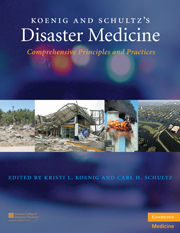Book contents
- Frontmatter
- Contents
- List of Contributors
- Contributor Biographies
- Foreword
- Preface
- Acknowledgments
- PART I CONCEPTUAL FRAMEWORK AND STRATEGIC OVERVIEW
- PART II OPERATIONAL ISSUES
- 9 Public Health and Emergency Management Systems
- 10 Legislative Authorities and Regulatory Issues
- 11 Syndromic Surveillance
- 12 Triage
- 13 Personal Protective Equipment
- 14 Decontamination
- 15 Quarantine
- 16 Mass Dispensing of Antibiotics and Vaccines
- 17 Management of Mass Gatherings
- 18 Transportation Disasters
- 19 Emergency Medical Services Scene Management
- 20 Healthcare Facility Disaster Management
- 21 Mass Fatality Management
- 22 Crisis and Emergency Risk Communication
- 23 Telemedicine and Telehealth Role in Public Health Emergencies
- 24 Complex Public Health Emergencies
- 25 Patient Identification and Tracking
- PART III CLINICAL MANAGEMENT
- Index
- Plate section
- References
23 - Telemedicine and Telehealth Role in Public Health Emergencies
from PART II - OPERATIONAL ISSUES
Published online by Cambridge University Press: 05 August 2011
- Frontmatter
- Contents
- List of Contributors
- Contributor Biographies
- Foreword
- Preface
- Acknowledgments
- PART I CONCEPTUAL FRAMEWORK AND STRATEGIC OVERVIEW
- PART II OPERATIONAL ISSUES
- 9 Public Health and Emergency Management Systems
- 10 Legislative Authorities and Regulatory Issues
- 11 Syndromic Surveillance
- 12 Triage
- 13 Personal Protective Equipment
- 14 Decontamination
- 15 Quarantine
- 16 Mass Dispensing of Antibiotics and Vaccines
- 17 Management of Mass Gatherings
- 18 Transportation Disasters
- 19 Emergency Medical Services Scene Management
- 20 Healthcare Facility Disaster Management
- 21 Mass Fatality Management
- 22 Crisis and Emergency Risk Communication
- 23 Telemedicine and Telehealth Role in Public Health Emergencies
- 24 Complex Public Health Emergencies
- 25 Patient Identification and Tracking
- PART III CLINICAL MANAGEMENT
- Index
- Plate section
- References
Summary
OVERVIEW
Telemedicine and Telehealth
Telemedicine involves the use of electronic information and telecommunications technologies to deliver medical care services in situations in which patients and providers are separated by geographical distance. Telemedicine technologies enable consultations and/or care delivery to take place remotely. Telemedicine has a role in improving access to care, for example in rural and remote areas that are medically underserved. Worldwide, people are becoming increasingly connected by a variety of telecommunications technology platforms. Existing and emerging applications on these telecommunications platforms are rapidly transforming homes and workplaces as well as how services such as healthcare will be provided. Hospitals and clinics have been the main locations for healthcare provision but technology is now taking aspects of these services into the home and local communities.
Telemedicine is a subset of telehealth. Telehealth encompasses a wider use of information and telecommunications technologies to deliver other aspects of healthcare. In addition to clinical consultations and care, telehealth includes the remote monitoring of health status, providing multimedia-based education to staff and offering information to patients to foster informed medical decision making. The role for telehealth in providing healthcare services in public health emergencies should be considered within the context of a changing social environment created by emerging technologies.
Keywords
- Type
- Chapter
- Information
- Koenig and Schultz's Disaster MedicineComprehensive Principles and Practices, pp. 345 - 360Publisher: Cambridge University PressPrint publication year: 2009



